University Assignment: BHP Portfolio Risk Management Report
VerifiedAdded on 2023/04/17
|14
|2452
|99
Report
AI Summary
This report provides a comprehensive overview of BHP's enterprise risk management practices. It begins with a project summary outlining BHP's strategic objectives of creating long-term value and managing its portfolio. The report then details the communication and authorization processes within BHP's portfolio management framework, emphasizing the role of the Portfolio Capital Allocation Working Group and the importance of clear, consistent communication with stakeholders. The core of the report focuses on portfolio risk management, including the internal framework overseen by the Risk and Audit Committee, risk identification categorized into business, financial, operational, sustainability, and external risks, and the risk assessment process conducted over a three-year viability assessment period. Furthermore, the report explores risk response strategies, including forecasting commodity prices, scenario planning, and signal tracking to mitigate potential negative impacts and capitalize on opportunities. The document highlights BHP's proactive approach to managing risks and achieving its strategic goals within a dynamic and uncertain environment.

2018 BHP Enterprise Risk Management Report 0
Uni Cover page
Uni Cover page
Paraphrase This Document
Need a fresh take? Get an instant paraphrase of this document with our AI Paraphraser
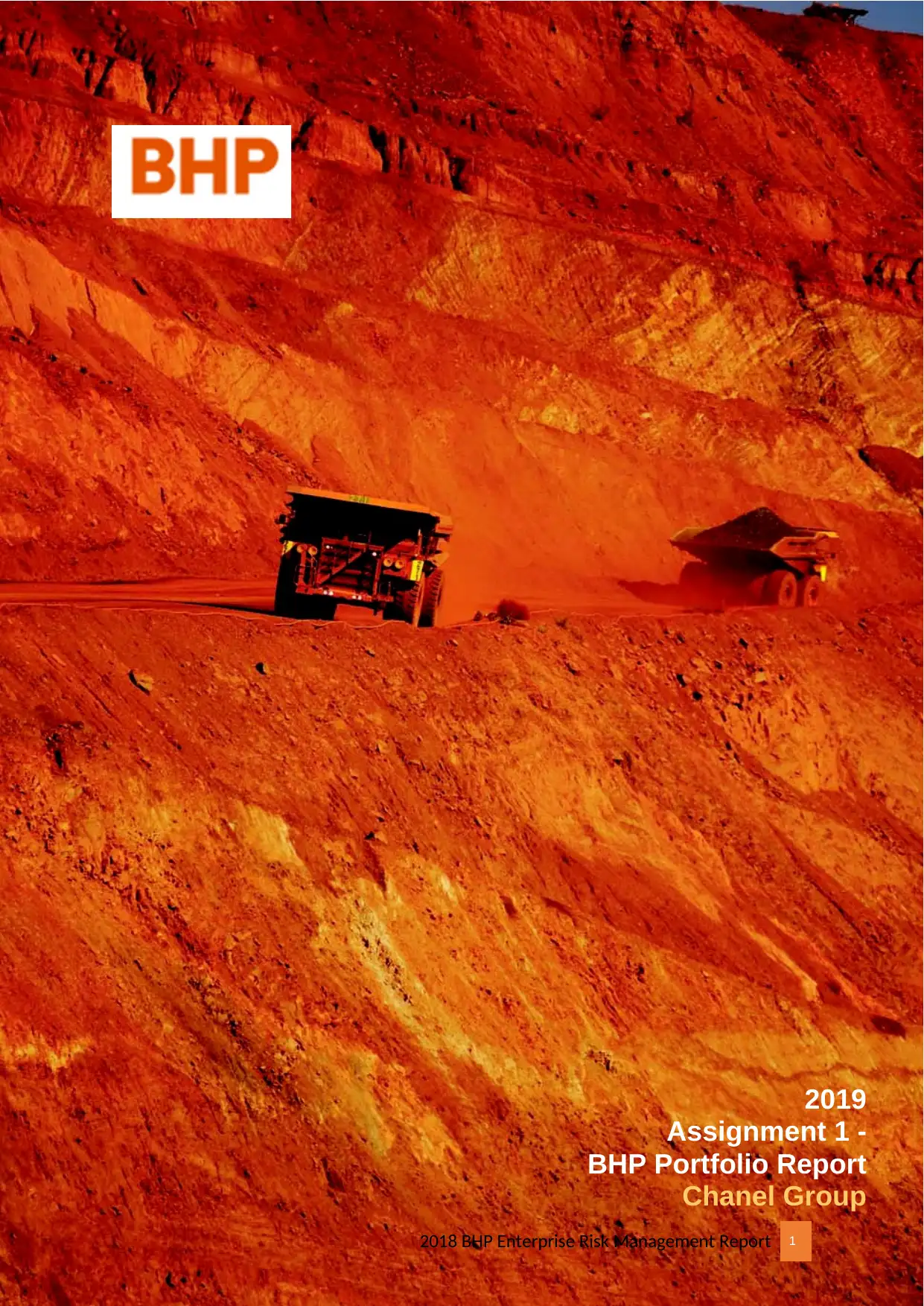
2019
Assignment 1 -
BHP Portfolio Report
Chanel Group
2018 BHP Enterprise Risk Management Report 1
Assignment 1 -
BHP Portfolio Report
Chanel Group
2018 BHP Enterprise Risk Management Report 1
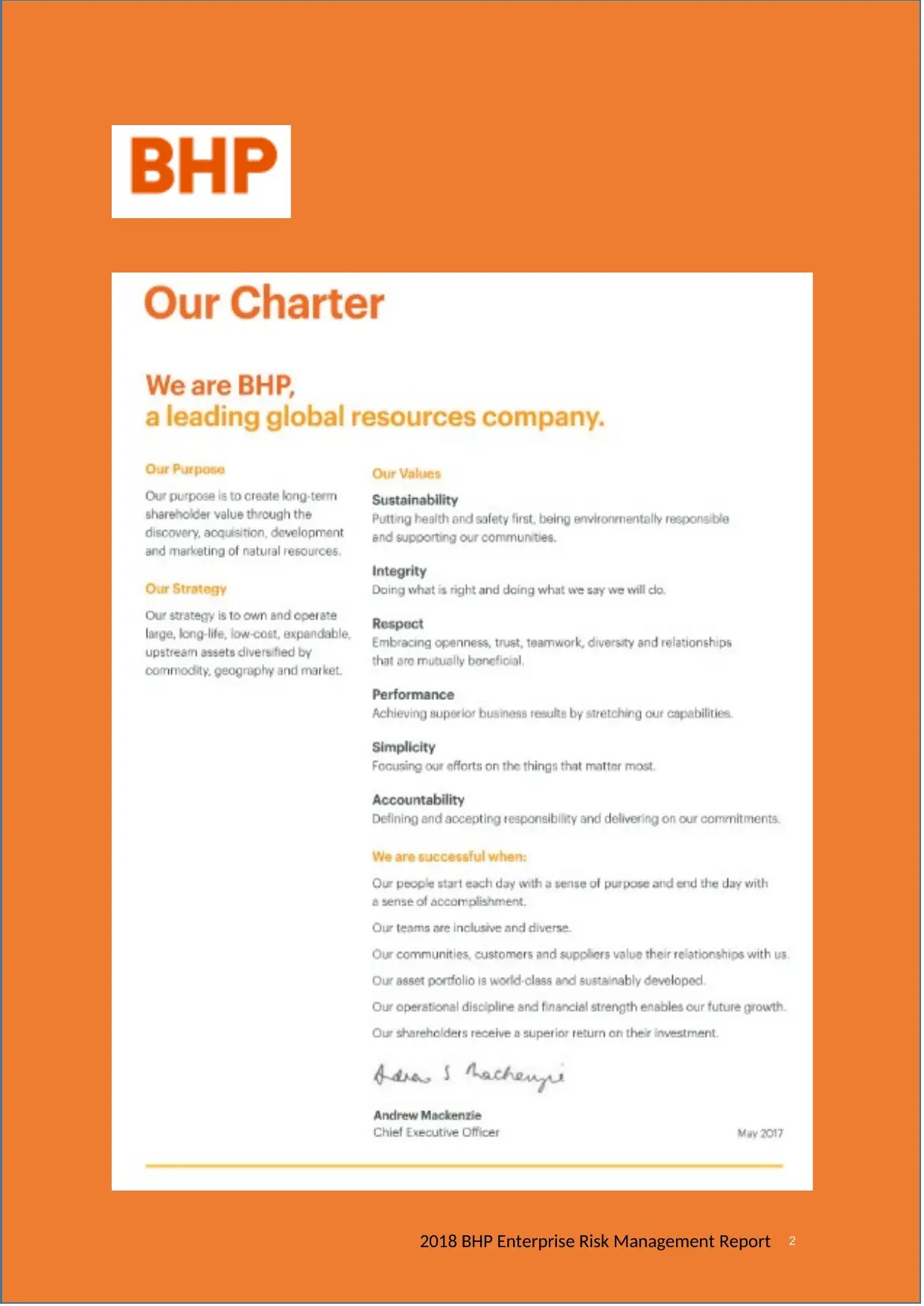
2018 BHP Enterprise Risk Management Report 2
⊘ This is a preview!⊘
Do you want full access?
Subscribe today to unlock all pages.

Trusted by 1+ million students worldwide

Table of Contents
Project Summary
Communication and Authorization……………………………………………
Portfolio Risk Management
1.0 Internal Framework…………………………………………………………………………....
2.0 Objective Setting……………………………………………………………………………….
3.0 Risk Identification………………………………………………………………………………
4.0 Risk Assessment………………………………………………………………………………
5.0 Risk Response………………………………………………………………………………..
6.0 Control Activities……………………………………………………………………………...
……………………………………………………………………………………..
[Word Count ]
2018 BHP Enterprise Risk Management Report 3
Project Summary
Communication and Authorization……………………………………………
Portfolio Risk Management
1.0 Internal Framework…………………………………………………………………………....
2.0 Objective Setting……………………………………………………………………………….
3.0 Risk Identification………………………………………………………………………………
4.0 Risk Assessment………………………………………………………………………………
5.0 Risk Response………………………………………………………………………………..
6.0 Control Activities……………………………………………………………………………...
……………………………………………………………………………………..
[Word Count ]
2018 BHP Enterprise Risk Management Report 3
Paraphrase This Document
Need a fresh take? Get an instant paraphrase of this document with our AI Paraphraser
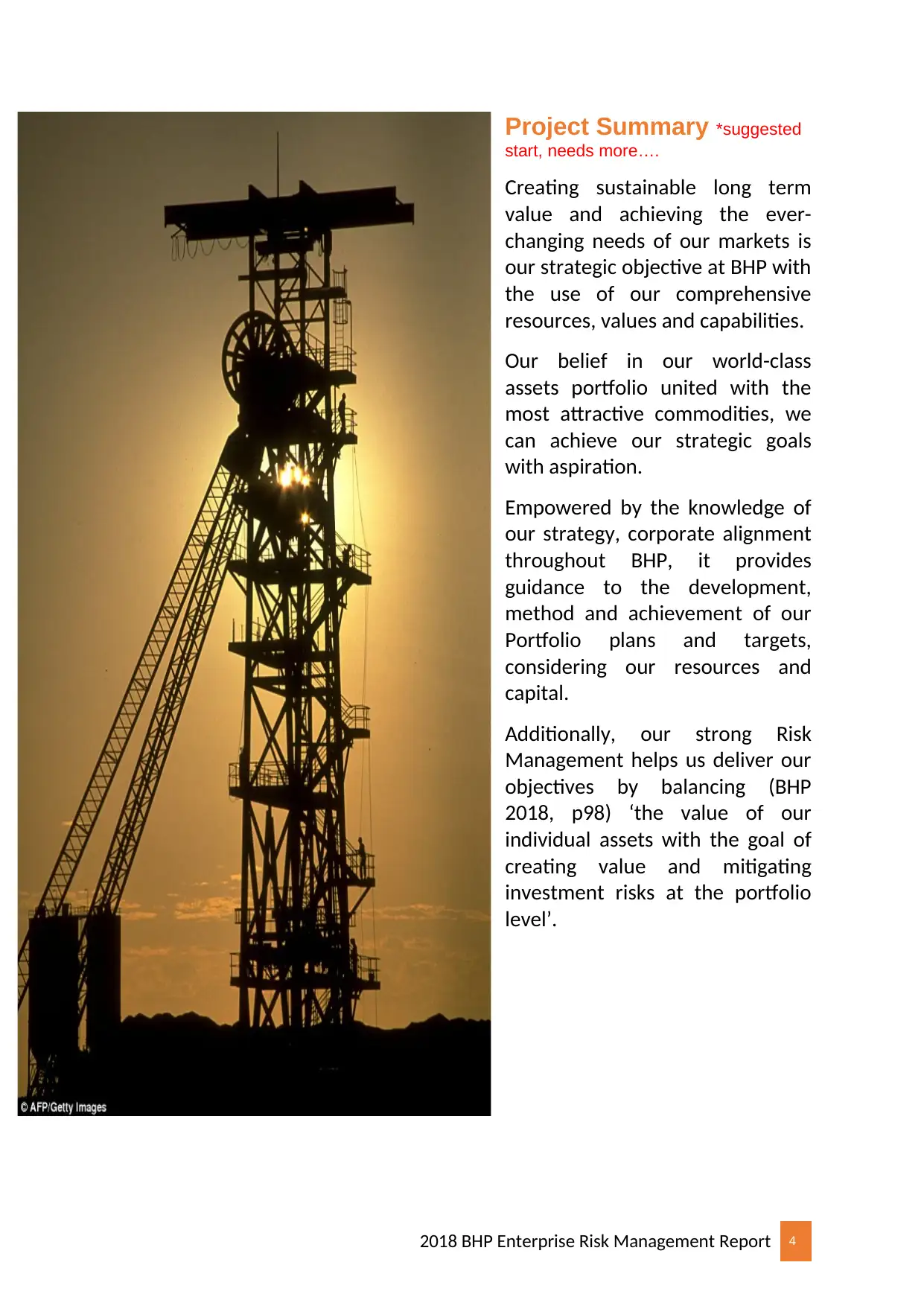
Project Summary *suggested
start, needs more….
Creating sustainable long term
value and achieving the ever-
changing needs of our markets is
our strategic objective at BHP with
the use of our comprehensive
resources, values and capabilities.
Our belief in our world-class
assets portfolio united with the
most attractive commodities, we
can achieve our strategic goals
with aspiration.
Empowered by the knowledge of
our strategy, corporate alignment
throughout BHP, it provides
guidance to the development,
method and achievement of our
Portfolio plans and targets,
considering our resources and
capital.
Additionally, our strong Risk
Management helps us deliver our
objectives by balancing (BHP
2018, p98) ‘the value of our
individual assets with the goal of
creating value and mitigating
investment risks at the portfolio
level’.
2018 BHP Enterprise Risk Management Report 4
start, needs more….
Creating sustainable long term
value and achieving the ever-
changing needs of our markets is
our strategic objective at BHP with
the use of our comprehensive
resources, values and capabilities.
Our belief in our world-class
assets portfolio united with the
most attractive commodities, we
can achieve our strategic goals
with aspiration.
Empowered by the knowledge of
our strategy, corporate alignment
throughout BHP, it provides
guidance to the development,
method and achievement of our
Portfolio plans and targets,
considering our resources and
capital.
Additionally, our strong Risk
Management helps us deliver our
objectives by balancing (BHP
2018, p98) ‘the value of our
individual assets with the goal of
creating value and mitigating
investment risks at the portfolio
level’.
2018 BHP Enterprise Risk Management Report 4
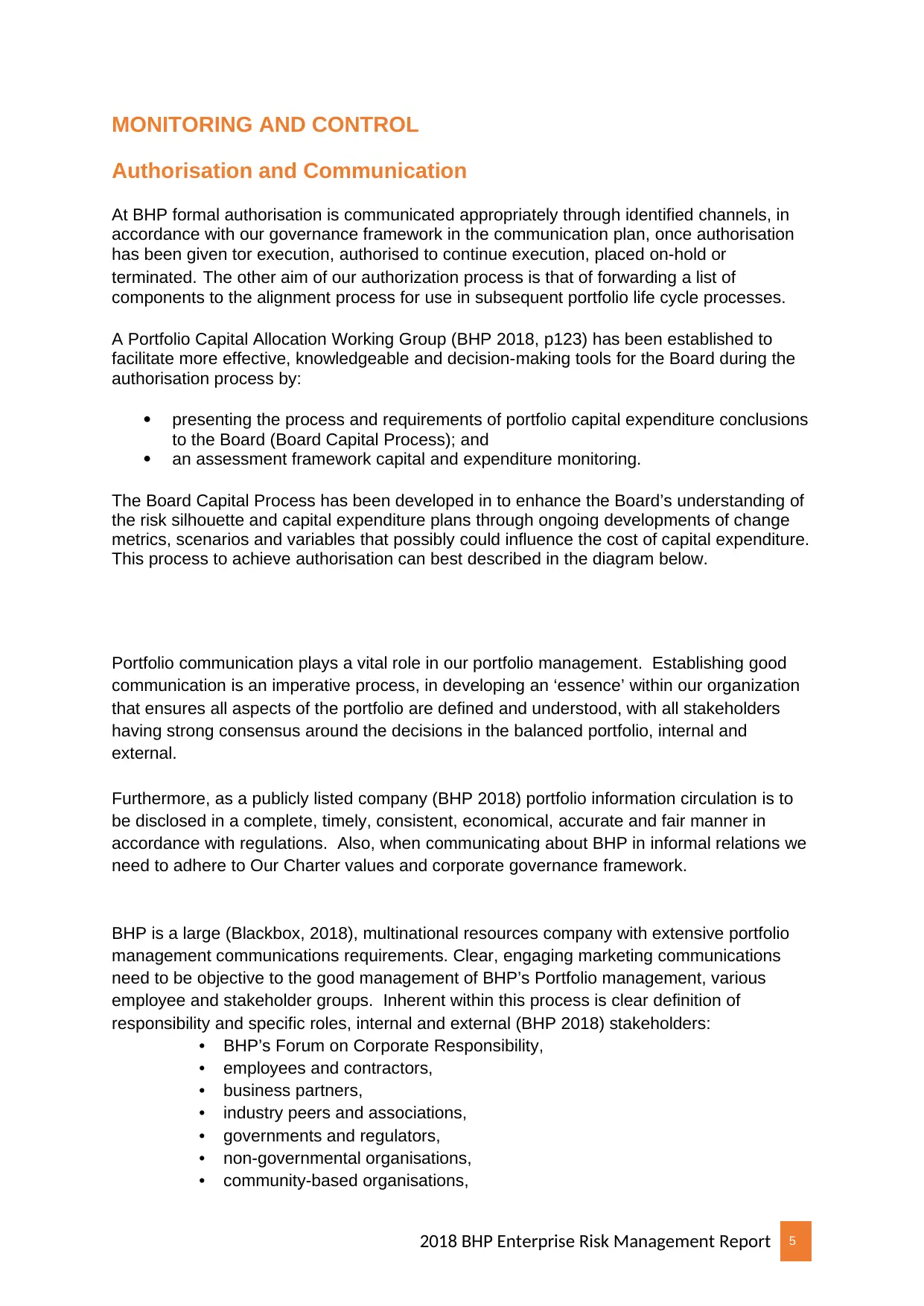
MONITORING AND CONTROL
Authorisation and Communication
At BHP formal authorisation is communicated appropriately through identified channels, in
accordance with our governance framework in the communication plan, once authorisation
has been given tor execution, authorised to continue execution, placed on-hold or
terminated. The other aim of our authorization process is that of forwarding a list of
components to the alignment process for use in subsequent portfolio life cycle processes.
A Portfolio Capital Allocation Working Group (BHP 2018, p123) has been established to
facilitate more effective, knowledgeable and decision-making tools for the Board during the
authorisation process by:
presenting the process and requirements of portfolio capital expenditure conclusions
to the Board (Board Capital Process); and
an assessment framework capital and expenditure monitoring.
The Board Capital Process has been developed in to enhance the Board’s understanding of
the risk silhouette and capital expenditure plans through ongoing developments of change
metrics, scenarios and variables that possibly could influence the cost of capital expenditure.
This process to achieve authorisation can best described in the diagram below.
Portfolio communication plays a vital role in our portfolio management. Establishing good
communication is an imperative process, in developing an ‘essence’ within our organization
that ensures all aspects of the portfolio are defined and understood, with all stakeholders
having strong consensus around the decisions in the balanced portfolio, internal and
external.
Furthermore, as a publicly listed company (BHP 2018) portfolio information circulation is to
be disclosed in a complete, timely, consistent, economical, accurate and fair manner in
accordance with regulations. Also, when communicating about BHP in informal relations we
need to adhere to Our Charter values and corporate governance framework.
BHP is a large (Blackbox, 2018), multinational resources company with extensive portfolio
management communications requirements. Clear, engaging marketing communications
need to be objective to the good management of BHP’s Portfolio management, various
employee and stakeholder groups. Inherent within this process is clear definition of
responsibility and specific roles, internal and external (BHP 2018) stakeholders:
• BHP’s Forum on Corporate Responsibility,
• employees and contractors,
• business partners,
• industry peers and associations,
• governments and regulators,
• non-governmental organisations,
• community-based organisations,
2018 BHP Enterprise Risk Management Report 5
Authorisation and Communication
At BHP formal authorisation is communicated appropriately through identified channels, in
accordance with our governance framework in the communication plan, once authorisation
has been given tor execution, authorised to continue execution, placed on-hold or
terminated. The other aim of our authorization process is that of forwarding a list of
components to the alignment process for use in subsequent portfolio life cycle processes.
A Portfolio Capital Allocation Working Group (BHP 2018, p123) has been established to
facilitate more effective, knowledgeable and decision-making tools for the Board during the
authorisation process by:
presenting the process and requirements of portfolio capital expenditure conclusions
to the Board (Board Capital Process); and
an assessment framework capital and expenditure monitoring.
The Board Capital Process has been developed in to enhance the Board’s understanding of
the risk silhouette and capital expenditure plans through ongoing developments of change
metrics, scenarios and variables that possibly could influence the cost of capital expenditure.
This process to achieve authorisation can best described in the diagram below.
Portfolio communication plays a vital role in our portfolio management. Establishing good
communication is an imperative process, in developing an ‘essence’ within our organization
that ensures all aspects of the portfolio are defined and understood, with all stakeholders
having strong consensus around the decisions in the balanced portfolio, internal and
external.
Furthermore, as a publicly listed company (BHP 2018) portfolio information circulation is to
be disclosed in a complete, timely, consistent, economical, accurate and fair manner in
accordance with regulations. Also, when communicating about BHP in informal relations we
need to adhere to Our Charter values and corporate governance framework.
BHP is a large (Blackbox, 2018), multinational resources company with extensive portfolio
management communications requirements. Clear, engaging marketing communications
need to be objective to the good management of BHP’s Portfolio management, various
employee and stakeholder groups. Inherent within this process is clear definition of
responsibility and specific roles, internal and external (BHP 2018) stakeholders:
• BHP’s Forum on Corporate Responsibility,
• employees and contractors,
• business partners,
• industry peers and associations,
• governments and regulators,
• non-governmental organisations,
• community-based organisations,
2018 BHP Enterprise Risk Management Report 5
⊘ This is a preview!⊘
Do you want full access?
Subscribe today to unlock all pages.

Trusted by 1+ million students worldwide

• local and Indigenous communities,
• labour unions,
• media,
• suppliers and customers,
• shareholders and investment organisations
Portfolio Risk Management
The aim of our Portfolio Risk Management framework is to reduce the impact and likelihood
of negative events occurring whilst focusing on to increase the positive outcomes through
opportunities, (BHP 2018, p 27) based on a 3 year viability assessment period.
Internal Framework
At BHP there is a Risk and Audit committee (BHP 2018) within the governance structure
which oversees and monitors risk, the governance framework at BHP can best be described
in the diagram 1 below. The Board has overall responsibility for BHP’s Portfolio risk profile,
whilst the Risk and Audit committee (RAC) provide assistance to the oversight of the risk
management.
Diagram 1. (BHP 2018, p97)
A process utilising a wide-range of scenarios gives guidance to the Board’s aim in portfolio
management with consideration to risk and taking into account society beliefs, commodity
and energy requirements.
2018 BHP Enterprise Risk Management Report 6
• labour unions,
• media,
• suppliers and customers,
• shareholders and investment organisations
Portfolio Risk Management
The aim of our Portfolio Risk Management framework is to reduce the impact and likelihood
of negative events occurring whilst focusing on to increase the positive outcomes through
opportunities, (BHP 2018, p 27) based on a 3 year viability assessment period.
Internal Framework
At BHP there is a Risk and Audit committee (BHP 2018) within the governance structure
which oversees and monitors risk, the governance framework at BHP can best be described
in the diagram 1 below. The Board has overall responsibility for BHP’s Portfolio risk profile,
whilst the Risk and Audit committee (RAC) provide assistance to the oversight of the risk
management.
Diagram 1. (BHP 2018, p97)
A process utilising a wide-range of scenarios gives guidance to the Board’s aim in portfolio
management with consideration to risk and taking into account society beliefs, commodity
and energy requirements.
2018 BHP Enterprise Risk Management Report 6
Paraphrase This Document
Need a fresh take? Get an instant paraphrase of this document with our AI Paraphraser

Risk Identification
A risk is an uncertain event or conditions that if they occur will either have a positive effect or
negative effect on our Portfolio. For BHP (BHP 2018, p12) to achieve and create long-term
value added alignment to our charter, identifying and managing risk is essential to our
portfolio.
Below is a table of the identified portfolio risks (BHP 2018) for BHP categorised into 5 types,
1. Business, 2. Financial, 3. Operational, 4. Sustainability, 5. External.
Risk Type Category Events Consequences/ Impacts
1. Business 1.1. Inability to discover or procure
new resources, develop new
assets or maintain, as outlined in
the portfolio.
Uncertain future financial
condition and results would be
negatively affected. Inability to
achieve portfolio goals,
decreased share holder return.
1.2. Through merger, divestment and
acquisition activity possible
changes to our portfolio of assets
Market reaction adverse, failure
to achieve portfolio
expectations, delayed cost
savings, possible material
inauspicious impact on our
future financial results and
condition, unable to finance
portfolio
1.3. Portfolio development projects
affected by increased costs and
schedule delays
Possible development projects
adversely affected, schedule
delays, portfolio realignment
4. Financial 2.1 Significant deterioration of cash
flow and our liquidity
Possible inability to finance our
major portfolio programs
2.2 Inability to entirely recuperate our
investments in gas, mining, and
oil assets
Possible financial write-downs,
adverse financial results, as
well as goodwill, inability to
finance portfolio initiatives as
desired
2.3 Failure of our commercial
counterparties to meet their
requirements that we conduct
business with
Possible credit exposure,
resulting in negative effects on
our result, portfolio finance
adversely affected
2018 BHP Enterprise Risk Management Report 7
A risk is an uncertain event or conditions that if they occur will either have a positive effect or
negative effect on our Portfolio. For BHP (BHP 2018, p12) to achieve and create long-term
value added alignment to our charter, identifying and managing risk is essential to our
portfolio.
Below is a table of the identified portfolio risks (BHP 2018) for BHP categorised into 5 types,
1. Business, 2. Financial, 3. Operational, 4. Sustainability, 5. External.
Risk Type Category Events Consequences/ Impacts
1. Business 1.1. Inability to discover or procure
new resources, develop new
assets or maintain, as outlined in
the portfolio.
Uncertain future financial
condition and results would be
negatively affected. Inability to
achieve portfolio goals,
decreased share holder return.
1.2. Through merger, divestment and
acquisition activity possible
changes to our portfolio of assets
Market reaction adverse, failure
to achieve portfolio
expectations, delayed cost
savings, possible material
inauspicious impact on our
future financial results and
condition, unable to finance
portfolio
1.3. Portfolio development projects
affected by increased costs and
schedule delays
Possible development projects
adversely affected, schedule
delays, portfolio realignment
4. Financial 2.1 Significant deterioration of cash
flow and our liquidity
Possible inability to finance our
major portfolio programs
2.2 Inability to entirely recuperate our
investments in gas, mining, and
oil assets
Possible financial write-downs,
adverse financial results, as
well as goodwill, inability to
finance portfolio initiatives as
desired
2.3 Failure of our commercial
counterparties to meet their
requirements that we conduct
business with
Possible credit exposure,
resulting in negative effects on
our result, portfolio finance
adversely affected
2018 BHP Enterprise Risk Management Report 7

Risk Type
Category
Events Consequences/ Impacts
7. Operational 3.1 Unpredicted operational and natural
catastrophes
Assets, people or assets
possibly adversely affected,
realignment of portfolio
3.2 Operational technology services
and Information technology are
exposed to cybersecurity risks
Our reputation and business
could possibly be materially
threatened, portfolio program
delays
3.3 Significant uncertainty from
Samarco dam failure increases are
potential liability from litigation
Possible material inauspicious
effect on our business. At this
time we are unable to reliably
estimate
3.4 Operating margins and expansion
plans negatively impacted from
cost stresses and low productivity,
conflicting operating standards and
management with Non-operated
joint ventures, or non-operated joint
ventures managed by other
companies
Failure to adopt BHP standards
equivalent we possibly could
take action contrary to our
standards, portfolio program
delays and additional costs
8. Sustainability 4.1 Climate change, health, community
impacts, environmental, safety and
accidents or incidents
Possibly our assets, people, and
licence to operate or reputation
negatively affected, realignment
of portfolio, delays to programs
and addition costs
9. External 5.1 Global economic volatility continues
and commodity price fluctuations
(including constant price shifts)
Possibly will negatively affect our
results, as well as asset values
and cash flows, portfolio finance
limited
5.2 Fluctuations in Exchange rate Possibly will have a negative
impact on BHP financial results,
ability to finance portfolio
5.3 Chinese demand downturn to
slowing in Economic growth
Lower prices for products,
adversely impact our results,
realignment of portfolio, reduced
2018 BHP Enterprise Risk Management Report 8
Category
Events Consequences/ Impacts
7. Operational 3.1 Unpredicted operational and natural
catastrophes
Assets, people or assets
possibly adversely affected,
realignment of portfolio
3.2 Operational technology services
and Information technology are
exposed to cybersecurity risks
Our reputation and business
could possibly be materially
threatened, portfolio program
delays
3.3 Significant uncertainty from
Samarco dam failure increases are
potential liability from litigation
Possible material inauspicious
effect on our business. At this
time we are unable to reliably
estimate
3.4 Operating margins and expansion
plans negatively impacted from
cost stresses and low productivity,
conflicting operating standards and
management with Non-operated
joint ventures, or non-operated joint
ventures managed by other
companies
Failure to adopt BHP standards
equivalent we possibly could
take action contrary to our
standards, portfolio program
delays and additional costs
8. Sustainability 4.1 Climate change, health, community
impacts, environmental, safety and
accidents or incidents
Possibly our assets, people, and
licence to operate or reputation
negatively affected, realignment
of portfolio, delays to programs
and addition costs
9. External 5.1 Global economic volatility continues
and commodity price fluctuations
(including constant price shifts)
Possibly will negatively affect our
results, as well as asset values
and cash flows, portfolio finance
limited
5.2 Fluctuations in Exchange rate Possibly will have a negative
impact on BHP financial results,
ability to finance portfolio
5.3 Chinese demand downturn to
slowing in Economic growth
Lower prices for products,
adversely impact our results,
realignment of portfolio, reduced
2018 BHP Enterprise Risk Management Report 8
⊘ This is a preview!⊘
Do you want full access?
Subscribe today to unlock all pages.

Trusted by 1+ million students worldwide
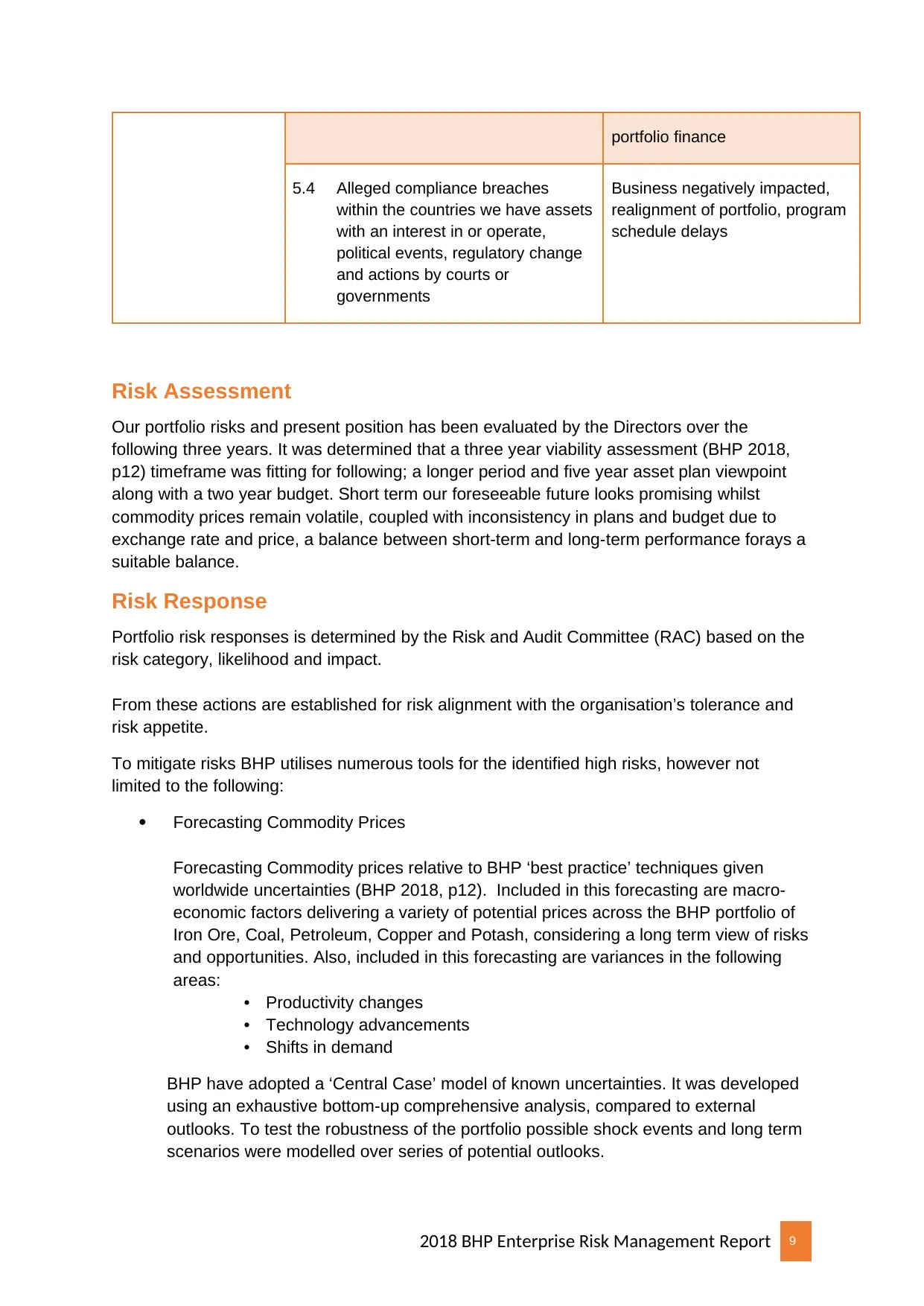
portfolio finance
5.4 Alleged compliance breaches
within the countries we have assets
with an interest in or operate,
political events, regulatory change
and actions by courts or
governments
Business negatively impacted,
realignment of portfolio, program
schedule delays
Risk Assessment
Our portfolio risks and present position has been evaluated by the Directors over the
following three years. It was determined that a three year viability assessment (BHP 2018,
p12) timeframe was fitting for following; a longer period and five year asset plan viewpoint
along with a two year budget. Short term our foreseeable future looks promising whilst
commodity prices remain volatile, coupled with inconsistency in plans and budget due to
exchange rate and price, a balance between short-term and long-term performance forays a
suitable balance.
Risk Response
Portfolio risk responses is determined by the Risk and Audit Committee (RAC) based on the
risk category, likelihood and impact.
From these actions are established for risk alignment with the organisation’s tolerance and
risk appetite.
To mitigate risks BHP utilises numerous tools for the identified high risks, however not
limited to the following:
Forecasting Commodity Prices
Forecasting Commodity prices relative to BHP ‘best practice’ techniques given
worldwide uncertainties (BHP 2018, p12). Included in this forecasting are macro-
economic factors delivering a variety of potential prices across the BHP portfolio of
Iron Ore, Coal, Petroleum, Copper and Potash, considering a long term view of risks
and opportunities. Also, included in this forecasting are variances in the following
areas:
• Productivity changes
• Technology advancements
• Shifts in demand
BHP have adopted a ‘Central Case’ model of known uncertainties. It was developed
using an exhaustive bottom-up comprehensive analysis, compared to external
outlooks. To test the robustness of the portfolio possible shock events and long term
scenarios were modelled over series of potential outlooks.
2018 BHP Enterprise Risk Management Report 9
5.4 Alleged compliance breaches
within the countries we have assets
with an interest in or operate,
political events, regulatory change
and actions by courts or
governments
Business negatively impacted,
realignment of portfolio, program
schedule delays
Risk Assessment
Our portfolio risks and present position has been evaluated by the Directors over the
following three years. It was determined that a three year viability assessment (BHP 2018,
p12) timeframe was fitting for following; a longer period and five year asset plan viewpoint
along with a two year budget. Short term our foreseeable future looks promising whilst
commodity prices remain volatile, coupled with inconsistency in plans and budget due to
exchange rate and price, a balance between short-term and long-term performance forays a
suitable balance.
Risk Response
Portfolio risk responses is determined by the Risk and Audit Committee (RAC) based on the
risk category, likelihood and impact.
From these actions are established for risk alignment with the organisation’s tolerance and
risk appetite.
To mitigate risks BHP utilises numerous tools for the identified high risks, however not
limited to the following:
Forecasting Commodity Prices
Forecasting Commodity prices relative to BHP ‘best practice’ techniques given
worldwide uncertainties (BHP 2018, p12). Included in this forecasting are macro-
economic factors delivering a variety of potential prices across the BHP portfolio of
Iron Ore, Coal, Petroleum, Copper and Potash, considering a long term view of risks
and opportunities. Also, included in this forecasting are variances in the following
areas:
• Productivity changes
• Technology advancements
• Shifts in demand
BHP have adopted a ‘Central Case’ model of known uncertainties. It was developed
using an exhaustive bottom-up comprehensive analysis, compared to external
outlooks. To test the robustness of the portfolio possible shock events and long term
scenarios were modelled over series of potential outlooks.
2018 BHP Enterprise Risk Management Report 9
Paraphrase This Document
Need a fresh take? Get an instant paraphrase of this document with our AI Paraphraser
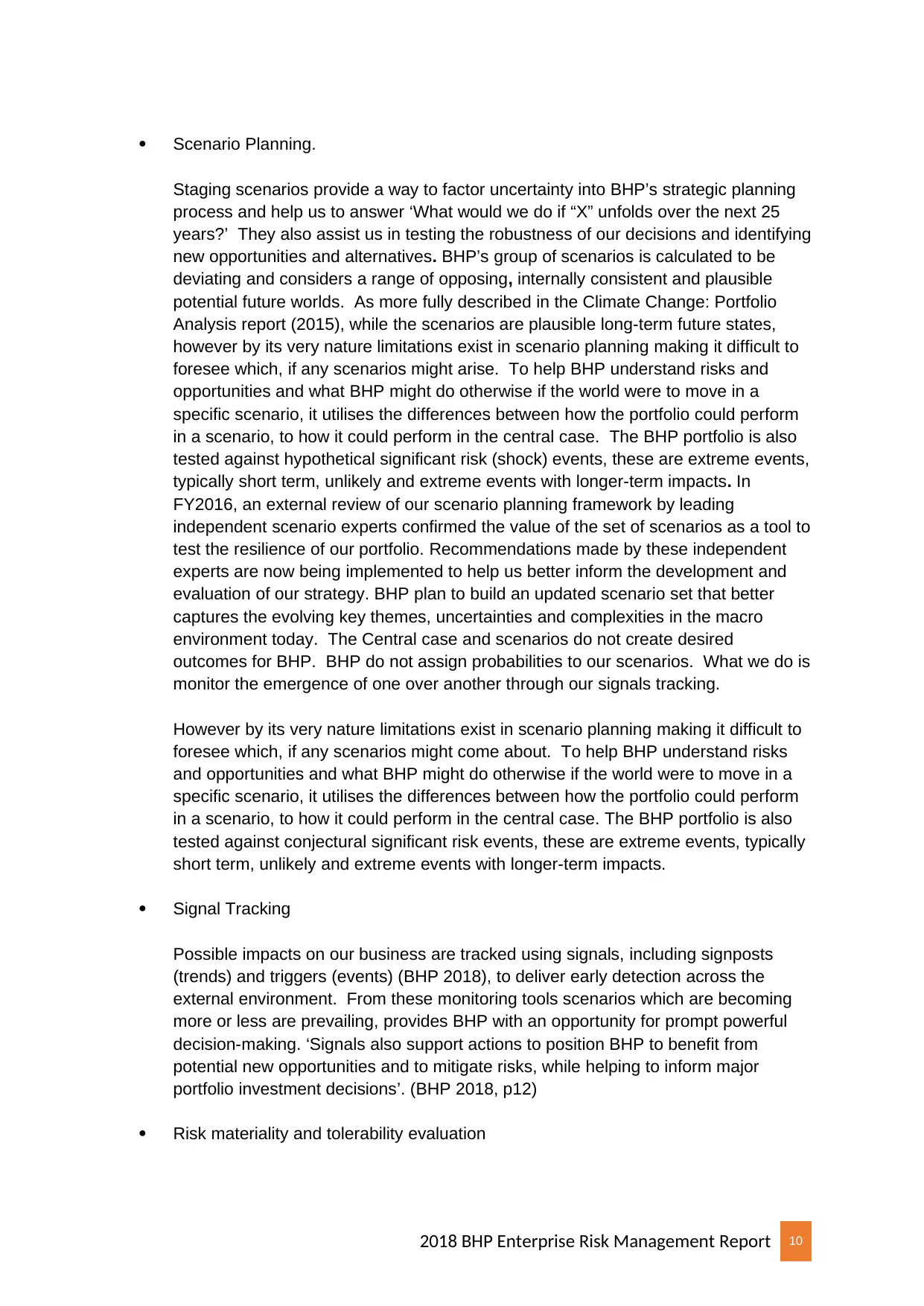
Scenario Planning.
Staging scenarios provide a way to factor uncertainty into BHP’s strategic planning
process and help us to answer ‘What would we do if “X” unfolds over the next 25
years?’ They also assist us in testing the robustness of our decisions and identifying
new opportunities and alternatives. BHP’s group of scenarios is calculated to be
deviating and considers a range of opposing, internally consistent and plausible
potential future worlds. As more fully described in the Climate Change: Portfolio
Analysis report (2015), while the scenarios are plausible long-term future states,
however by its very nature limitations exist in scenario planning making it difficult to
foresee which, if any scenarios might arise. To help BHP understand risks and
opportunities and what BHP might do otherwise if the world were to move in a
specific scenario, it utilises the differences between how the portfolio could perform
in a scenario, to how it could perform in the central case. The BHP portfolio is also
tested against hypothetical significant risk (shock) events, these are extreme events,
typically short term, unlikely and extreme events with longer-term impacts. In
FY2016, an external review of our scenario planning framework by leading
independent scenario experts confirmed the value of the set of scenarios as a tool to
test the resilience of our portfolio. Recommendations made by these independent
experts are now being implemented to help us better inform the development and
evaluation of our strategy. BHP plan to build an updated scenario set that better
captures the evolving key themes, uncertainties and complexities in the macro
environment today. The Central case and scenarios do not create desired
outcomes for BHP. BHP do not assign probabilities to our scenarios. What we do is
monitor the emergence of one over another through our signals tracking.
However by its very nature limitations exist in scenario planning making it difficult to
foresee which, if any scenarios might come about. To help BHP understand risks
and opportunities and what BHP might do otherwise if the world were to move in a
specific scenario, it utilises the differences between how the portfolio could perform
in a scenario, to how it could perform in the central case. The BHP portfolio is also
tested against conjectural significant risk events, these are extreme events, typically
short term, unlikely and extreme events with longer-term impacts.
Signal Tracking
Possible impacts on our business are tracked using signals, including signposts
(trends) and triggers (events) (BHP 2018), to deliver early detection across the
external environment. From these monitoring tools scenarios which are becoming
more or less are prevailing, provides BHP with an opportunity for prompt powerful
decision-making. ‘Signals also support actions to position BHP to benefit from
potential new opportunities and to mitigate risks, while helping to inform major
portfolio investment decisions’. (BHP 2018, p12)
Risk materiality and tolerability evaluation
2018 BHP Enterprise Risk Management Report 10
Staging scenarios provide a way to factor uncertainty into BHP’s strategic planning
process and help us to answer ‘What would we do if “X” unfolds over the next 25
years?’ They also assist us in testing the robustness of our decisions and identifying
new opportunities and alternatives. BHP’s group of scenarios is calculated to be
deviating and considers a range of opposing, internally consistent and plausible
potential future worlds. As more fully described in the Climate Change: Portfolio
Analysis report (2015), while the scenarios are plausible long-term future states,
however by its very nature limitations exist in scenario planning making it difficult to
foresee which, if any scenarios might arise. To help BHP understand risks and
opportunities and what BHP might do otherwise if the world were to move in a
specific scenario, it utilises the differences between how the portfolio could perform
in a scenario, to how it could perform in the central case. The BHP portfolio is also
tested against hypothetical significant risk (shock) events, these are extreme events,
typically short term, unlikely and extreme events with longer-term impacts. In
FY2016, an external review of our scenario planning framework by leading
independent scenario experts confirmed the value of the set of scenarios as a tool to
test the resilience of our portfolio. Recommendations made by these independent
experts are now being implemented to help us better inform the development and
evaluation of our strategy. BHP plan to build an updated scenario set that better
captures the evolving key themes, uncertainties and complexities in the macro
environment today. The Central case and scenarios do not create desired
outcomes for BHP. BHP do not assign probabilities to our scenarios. What we do is
monitor the emergence of one over another through our signals tracking.
However by its very nature limitations exist in scenario planning making it difficult to
foresee which, if any scenarios might come about. To help BHP understand risks
and opportunities and what BHP might do otherwise if the world were to move in a
specific scenario, it utilises the differences between how the portfolio could perform
in a scenario, to how it could perform in the central case. The BHP portfolio is also
tested against conjectural significant risk events, these are extreme events, typically
short term, unlikely and extreme events with longer-term impacts.
Signal Tracking
Possible impacts on our business are tracked using signals, including signposts
(trends) and triggers (events) (BHP 2018), to deliver early detection across the
external environment. From these monitoring tools scenarios which are becoming
more or less are prevailing, provides BHP with an opportunity for prompt powerful
decision-making. ‘Signals also support actions to position BHP to benefit from
potential new opportunities and to mitigate risks, while helping to inform major
portfolio investment decisions’. (BHP 2018, p12)
Risk materiality and tolerability evaluation
2018 BHP Enterprise Risk Management Report 10

Risk materiality (BHP 2018) is based on a series of iterative calculations using a
combined, quantitative scoring charter. Inputs are from comprehensive engagement
with BHP senior executives and external sources from government, environmental
organisations, industry and community, following these inputs tolerability is
determined over the corresponding impacts:
> Legal
> Financial
> Environmental
> Reputational
> Health
> Community
> Safety
From the analysis, possible tolerability of the risk is assessed on a formulation of
signal effectiveness and residual risk.
Control Activities
Through procedures and policies Control actives are established to assist in
guaranteeing that our Executive Committee’s recommendations to mitigate Portfolio
risks are aligned with Strategy and carried out for the purposes to achieve defined
objectives.
Portfolio major investment toll-gating procedures is coordinated by the Investment
Review Committee (IRC), by giving an overview of investment procedures through BHP.
The IRC findings of the major capital works are communicated to the board. To ensure
timely, complete and accurate information is shared the Disclosure Committee manages
our abidance with regular disclosure requirements, through stock exchanges,
information review as well as compliance with our securities transactions.
2018 BHP Enterprise Risk Management Report 11
combined, quantitative scoring charter. Inputs are from comprehensive engagement
with BHP senior executives and external sources from government, environmental
organisations, industry and community, following these inputs tolerability is
determined over the corresponding impacts:
> Legal
> Financial
> Environmental
> Reputational
> Health
> Community
> Safety
From the analysis, possible tolerability of the risk is assessed on a formulation of
signal effectiveness and residual risk.
Control Activities
Through procedures and policies Control actives are established to assist in
guaranteeing that our Executive Committee’s recommendations to mitigate Portfolio
risks are aligned with Strategy and carried out for the purposes to achieve defined
objectives.
Portfolio major investment toll-gating procedures is coordinated by the Investment
Review Committee (IRC), by giving an overview of investment procedures through BHP.
The IRC findings of the major capital works are communicated to the board. To ensure
timely, complete and accurate information is shared the Disclosure Committee manages
our abidance with regular disclosure requirements, through stock exchanges,
information review as well as compliance with our securities transactions.
2018 BHP Enterprise Risk Management Report 11
⊘ This is a preview!⊘
Do you want full access?
Subscribe today to unlock all pages.

Trusted by 1+ million students worldwide
1 out of 14
Related Documents
Your All-in-One AI-Powered Toolkit for Academic Success.
+13062052269
info@desklib.com
Available 24*7 on WhatsApp / Email
![[object Object]](/_next/static/media/star-bottom.7253800d.svg)
Unlock your academic potential
Copyright © 2020–2025 A2Z Services. All Rights Reserved. Developed and managed by ZUCOL.




